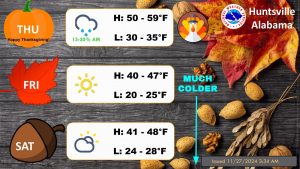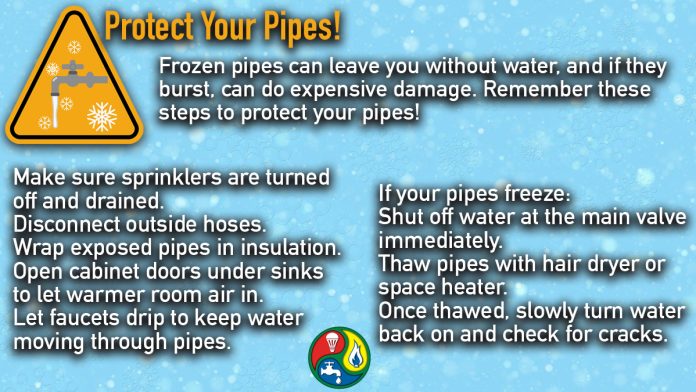HUNTSVILLE — With subfreezing temperatures in the forecast for this weekend, it’s time to take steps and prevent pipes and water lines from breaking.

One of the first steps is to disconnect hoses from the faucets. Even one night of freezing weather can cause pipes to break.
Also, remove hoses, splitters, or other fittings screwed onto the faucet. The hoses can trap water and make it much more likely a faucet will freeze.
Here are some other steps to take, according to thespruce.com:
- Check all spigots, yard hydrants, and other fixtures for leaks and drips. If you do find any problems, repair or replace the fixture before the temperature drops to freezing. Dripping water indicates a spigot with a leaky washer or cartridge, which can block up and freeze in the spigot or the pipe feeding it.
- Shut off the line and drain the water into a bucket while temperatures remain above freezing. Do this by shutting off an interior shut-off valve to the water line leading to the spigot. Open the spigot and leave it open for a few hours until the water inside the pipe drains. After the water drains out, close the spigot again.
- The last step to winterizing outdoor faucets is to protect them with insulation. Fit the faucet cover tightly over the faucet. There should be no gaps between the house and the cover. For cloth covers, cinch the drawstring tightly around the faucet, as close to the house as possible.
- Frost-free spigots should also be covered. Although they resist some freezing, they are not entirely frost-proof. The extra protection from the cold will benefit the gaskets and washers inside the frost-free spigots.
Meanwhile, Huntsville Utilities is offering these tips to help keep utility bills down as winter weather rolls in:
- Zone Heat: In very cold weather, zone heating can help keep your bill low but should not be used on a consistent basis due to possible mold problems. Close the doors and vents to the rooms that you are not frequently using and heat only the most important rooms in the house. You can do this if you have gas heat or an electric furnace but do not try it with a heat pump or an air conditioner since it may cause damage to the compressor. Also, try not to zone off the area in which the thermostat is located.
- Open and Close Your Curtains: Open your curtains on the south side of your house during the day. The sun sinks approximately 30 degrees to the south in the winter and will provide significant heating effect during the day. Close all other curtains day and night to reduce heat loss.
- Seal Your Windows: Check the outside edges of your windows for air gaps. If cracks exist, re-caulking is one of the most cost-effective measures you can take.Storm windows are very cost effective if applied over single pane glass, especially if a vinyl gasket is used. If your windows are in disrepair, clear plastic can be applied as a temporary measure on the window interior to seal against air infiltration.Window seals kits using a hair dryer to shrink the plastic until clear are available in most building supply stores.
- Seal Your Doors: The best way to seal an exterior door is with jamb-up weather-stripping and a threshold. A towel at the bottom of the door will suffice as a temporary measure.
- Wrap Your Water Heater: Most electric water heaters cost more to operate than natural gas but a little less than propane. Newer water heaters may have internal foam insulation and do not need a wrap but, in many cases, water heater jackets, duct wrap, or fiberglass batts can be a cost-effective way to save energy. NOTE: Be careful when insulating a gas water heater so as not to interfere with its ventilation at the top or the flame at the bottom. Water heater jackets can be used effectively to save energy for tanks located both inside and outside the heated space.
- Wrap Your Hot Water Pipes: Foam tubes make for very easy and effective insulation and can be purchased at most building supply stores.
- Check Your Attic Insulation: In most homes, one of the most significant areas of heat loss is through the ceiling. Make sure your attic has a level blanket of insulation that completely covers the ceiling joists. Insulation levels are measured in R-values and Huntsville Utilities recommends a minimum of R-25 and an optimum level of R-38. Attic access openings and pull down stairs located inside the structure should also be insulated and weather-stripped.
Don’t miss out! Subscribe to our email newsletter to have all our smart stories delivered to your inbox.



